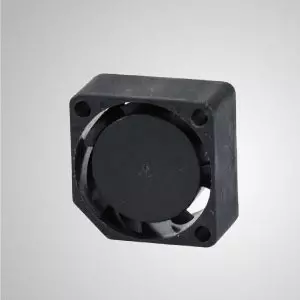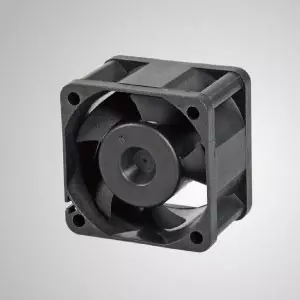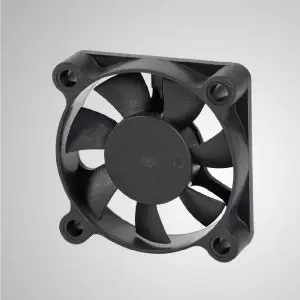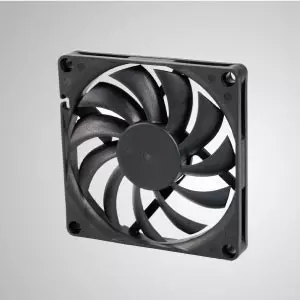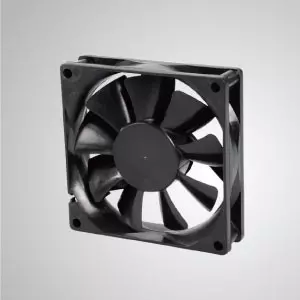[Cooling fan] What is a fan bearing?
The major function of fan bearing is to make fan blades operated fluently. The purpose of fan bearing is to reduce rotational friction and support axial loads. The fan bearing is the most critical factor in fan lifetime and fan performance. Without fan bearing, a cooling fan cannot work. When choosing a cooling fan, it considers not only airflow and static pressure but also the reliability of fan itself. It determines if a cooling fan can run consistently many years. The fan bearing is the critical role of fan.
Fan bearing comparison
| Fan bearing type | Recommend | Lifetime (25°) | Noise | Unit Price | TITAN Model |
|---|---|---|---|---|---|
Sleeve Bearing | Operation: 25-40°C Consider fan cost | 25,000 hours | Quieter at low speed in early life | Lowest | S |
One Ball & One Sleeve | Environment temperature is higher than 40°C | 35,000 hours | Quieter at high-speed | High | C |
Two Ball Bearing | Environment temperature is higher than 40°C | 50,000 hours | Quieter at high-speed | highest | B |
One Ball Bearing | 1. Environment temperature is higher than 40°C 2. Suitable for Slim fan | 50,000 hours | Quieter at high-speed Quieter than Two Ball bearing | Medium | |
Z-axis Bearing | 1. Operation: 25-40°C 2. Consider longer fan lifetime 3. Consider balance performance and cost | 60,000 hours |
| Low | Z |
TITAN Fan Bearing Comparison Chart

Brief Information of Fan Bearing: Sleeve bearing, ball bearing, and Z-Axis bearing
Sleeve Bearing
Sleeve bearing uses oil-base substances as lubrication to reduce friction in operation. The sleeve bearing is the most common bearing types of cooling fan and usually cheapest, but it has the problem of lubrication issue. If the lubricant of fan bearing evaporates and leaks, the fan system would be destroyed and became loudly. The sleeve bearing has a greater concentration of oil lubrication. Therefore, a sleeve bearing fan is most likely to evaporate and became noise in later life.
- Recommend: operation temperature between 25 - 40°C, consider lower fan cost
- Suitable for low-speed rate and below 90mm cooling fan.
- Lifetime (25°C): 25,000 hours
- Noise: Quieter at low speeds in early life
- Cost: Lowest
- TITAN bearing model: S
Ball Bearing
The ball bearing is a component of balls between the rings and designed to reduce friction and easily rotated. It has a longer lifetime (50,000 hours in 25°C) than sleeve bearing. A ball bearing fan is suitable for higher temperature operation and run more quietly at the high-speed but noisier at the low-speed.
- Recommend: operation environment is higher than 40°C
- Lifetime (25°C): 50,000 hours
- Noise: Quieter at high speeds
- Cost: Higher
- TITAN bearing model: B
Z-Axis Bearing
TITAN exclusive design fan bearing
TITAN Z-Axis fan bearing is a progress bearing which is fixed the weakness of sleeve bearing and ball bearing. It both has cheaper cost than ball bearing and longer lifetime and reliability than sleeve bearing. TITAN Z-axis bearing is reliable on the worldwide client as well.
- Recommend: Operation temperature between 25 - 40°C and need longer fan lifetime.
- Lifetime (25°C): 60,000 hours
- Noise: fixed the problem of concentration of oil in sleeve bearing.
- Cost: Low
- TITAN bearing model: Z
- Other FAQ
The major function of fan bearing is to make fan blades operated fluently. The purpose of fan bearing is to reduce rotational friction and support axial loads. The fan bearing is the most critical factor...
Read moreTITAN have three major bearing types: Sleeve bearing, Z-AXIS bearing, and Ball bearing. All the cooling fan depends on various need, lifetime, and characteristics to determine bearing choice.Sleeve Bearing:...
Read moreWithin a cooling fan, three key components play a vital role: the Integrated Circuit (IC), the Bearing, and the Fan Blades. Of these, the fan bearing significantly influences the overall lifespan and performance...
Read moreChoosing the right fan bearing is crucial for extending the fan’s lifespan and ensuring stable operation. TITAN offers three main bearing types: Ball Bearing, Z-AXIS (Long-Life Bearing), and Sleeve Bearing,...
Read more- Products
DC Cooling Fan with 17mm x 17mm x 8mm Series
TFD-1708xxxx
TITAN produced various professional and DC cooling Fan for customers. DC Cooling fan features...
DetailsDC Cooling Fan with 20mm x 20mm x 8mm Series
TFD-2008xxxx
TITAN produced various professional and DC cooling Fan for customers. DC Cooling fan features...
DetailsDC Cooling Fan with 25mm x 25mm x 10mm Series
TFD-2510xxxx
TITAN produced various professional and DC cooling Fan for customers. DC Cooling fan features...
DetailsDC Cooling Fan with 30mm x 30mm x 7mm Series
TFD-3007xxxx
TITAN produced various professional and DC cooling Fan for customers. DC Cooling fan features...
DetailsDC Cooling Fan with 30mm x 30mm x 10mm Series
TFD-3010xxxx
TITAN produced various professional and DC cooling Fan for customers. DC Cooling fan features...
DetailsDC Cooling Fan with 38mm x 38mm x 38mm Series
TFD-3838xxxx
TITAN produced various professional and DC cooling Fan for customers. DC Cooling fan features...
DetailsDC Cooling Fan with 40mm x 40mm x 7mm Series
TFD-4007xxxx
TITAN produced various professional and DC cooling Fan for customers. DC Cooling fan features...
DetailsDC Cooling Fan with 40mm x 40mm x 10mm Series
TFD-4010xxxx
TITAN produced various professional and DC cooling Fan for customers. DC Cooling fan features...
DetailsDC Cooling Fan with 40mm x 40mm x 20mm Series
TFD-4020xxxx
TITAN produced various professional and DC cooling Fan for customers. DC Cooling fan features...
DetailsDC Cooling Fan with 40mm x 40mm x 28mm Series
TFD-4028xxxx
TITAN produced various professional and DC cooling Fan for customers. DC Cooling fan features...
DetailsDC Cooling Fan with 45mm x 45mm x 10mm Series
TFD-4510xxxx
TITAN produced various professional and DC cooling Fan for customers. DC Cooling fan features...
DetailsDC Cooling Fan with 50mm x 50mm x 10mm Series
TFD-5010xxxx
TITAN produced various professional and DC cooling Fan for customers. DC Cooling fan features...
DetailsDC Cooling Fan with 50mm x 50mm x 15mm Series
TFD-5015xxxx
TITAN produced various professional and DC cooling Fan for customers. DC Cooling fan features...
DetailsDC Cooling Fan with 60mm x 60mm x 10mm Series
TFD-6010xxxx
TITAN produced various professional and DC cooling Fan for customers. DC Cooling fan features...
DetailsDC Cooling Fan with 60mm x 60mm x 15mm Series
TFD-6015xxxx
TITAN produced various professional and DC cooling Fan for customers. DC Cooling fan features...
DetailsDC Cooling Fan with 60mm x 60mm x 20mm Series
TFD-6020xxxx
TITAN produced various professional and DC cooling Fan for customers. DC Cooling fan features...
DetailsDC Cooling Fan with 60mm x 60mm x 25mm Series
TFD-6025xxxx
TITAN produced various professional and DC cooling Fan for customers. DC Cooling fan features...
DetailsDC Cooling Fan with 70mm x 70mm x 10mm Series
TFD-7010xxxx
TITAN produced various professional and DC cooling Fan for customers. DC Cooling fan features...
DetailsDC Cooling Fan with 70mm x 70mm x 15mm Series
TFD-7015xxxx
TITAN produced various professional and DC cooling Fan for customers. DC Cooling fan features...
DetailsDC Cooling Fan with 70mm x 70mm x 25mm Series
TFD-7025xxxx
TITAN produced various professional and DC cooling Fan for customers. DC Cooling fan features...
DetailsDC Cooling Fan with 80mm x 80mm x 10mm Series
TFD-8010xxxx
TITAN produced various professional and DC cooling Fan for customers. DC Cooling fan features...
DetailsDC Cooling Fan with 80mm x 80mm x 15mm Series
TFD-8015xxxx
TITAN produced various professional and DC cooling Fan for customers. DC Cooling fan features...
DetailsDC Cooling Fan with 80mm x 80mm x 20mm Series
TFD-8020xxxx
TITAN produced various professional and DC cooling Fan for customers. DC Cooling fan features...
DetailsDC Cooling Fan with 80mm x 80mm x 25mm Series
TFD-8025xxxx
TITAN produced various professional and DC cooling Fan for customers. DC Cooling fan features...
DetailsDC Cooling Fan with 80mm x 80mm x 35mm Series
TFD-8035xxxx
TITAN produced various professional and DC cooling Fan for customers. DC Cooling fan features...
DetailsDC Cooling Fan with 80mm x 80mm x 38mm Series
TFD-8038xxxx
TITAN produced various professional and DC cooling Fan for customers. DC Cooling fan features...
DetailsDC Cooling Fan with 92mm x 92mm x 25mm Series
TFD-9225xxxx
TITAN produced various professional and DC cooling Fan for customers. DC Cooling fan features...
DetailsDC Cooling Fan with 95mm x 95mm x 25mm Series
TFD-9525xxxx
TITAN produced various professional and DC cooling Fan for customers. DC Cooling fan features...
DetailsDC Cooling Fan with 120mm x 120mm x 25mm Series
TFD-12025xxxx
TITAN produced various professional and DC cooling Fan for customers. DC Cooling fan features...
DetailsDC Cooling Fan with 120mm x 120mm x 38mm Series
TFD-12038xxxx
TITAN produced various professional and DC cooling Fan for customers. DC Cooling fan features...
DetailsDC Cooling Fan with 140mm x 140mm x 25mm Series
TFD-14025xxxx
TITAN produced various professional and DC cooling Fan for customers. DC Cooling fan features...
Details

